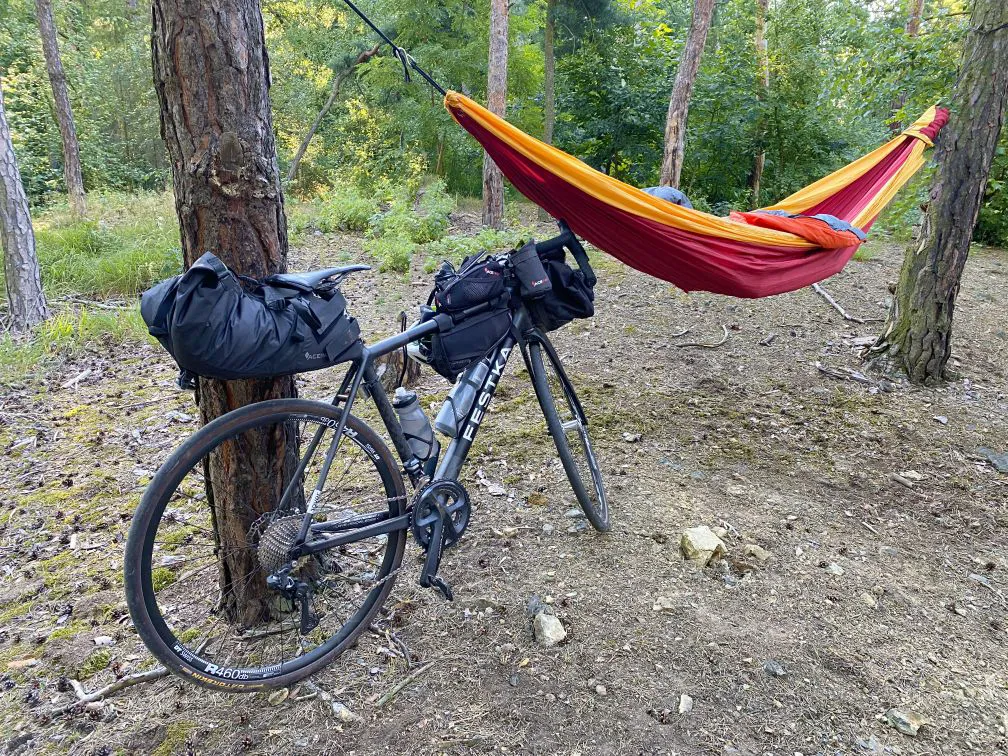The debate could go on forever, but we’ve provided a list of considerations to start you off…
1. Protection from the elements
This is really the sole purpose of your shelter, everything else you consider will only serve to make life easier. So of course you want to give it some thought. Depending on where you’re riding will determine the weather conditions for your trip. The shelter you choose will be, hopefully, keeping you safe and comfortable every night of your trip. Therefore you want to ask whether you’ll need certain levels of protection from the elements. Will it keep you warm, or maybe you’ll need protection against bugs and small animals.
A tent will likely keep you warmer and if you’ve got a 4-season tent then you can be mostly reassured that you’re protected from snow. A tarp on the other hand will have more airflow, making it cooler but you’ll avoid condensation. If you were to combine a tarp with a hammock then you could be protected against damp or muddy ground. Of course if there aren’t going to be many trees on your trip then a hammock won’t work.

2. Weight and size
Weight is a big consideration for your shelter and its components. It’s less important on a bikepacking trip if you’ll mostly be riding, but if you anticipate plenty of hike-a-bike then you’ll be wanting to cut the weight where possible.
There are plenty of high-end lightweight tents on the market but it’s possible that utilising a tarp set-up with your bike wheels will cut down weight considerably. There is the advantage of not carrying poles too which will add weight and bulkiness to your setup. Carbon fibre poles are the lightest and most durable tent poles you can get, so if you’ve got the cash then you can splash out on these.
3. Location
Will you be able to find appropriate places to set up your shelter? Are there any locations which limit your pitching opportunities? For example, if your setup consists of a hammock and tarp, then you’ll need trees. This likely won’t be much use if you’re bikepacking across the desert. Where there are trees, are your straps big enough to fit around the type of tree you’re likely to come across? Maybe the trees are too weak to withstand the weight of a hammock and person. You want to consider these factors before you arrive at your camp.
Of course tents have their drawbacks too with regards to a location. With a tent you want to find flat and relatively dry ground that is capable of holding your stakes. With a tarp, this isn’t as crucial. It’s even less so if you’ve got a hammock as part of your setup.
4. Bike and gear storage
Depending on where you’re camping, you may want to be able to see your bike. I don’t recommend taking it into your tent with you and risking your groundsheet. Whatever you choose to do, you need to have enough space for your bags and of course space for yourself too.
The best option in a scenario where you want your bike close by is to use your wheels as part of your shelter. This can be easily done with a tarp – though you might want to practise at home first. You then need to ensure you have plenty of space to store your bags too.
You may be somewhere wild and remote so it’s likely your bike will be completely safe outside of your tent but it’s certainly worth considering.
5. Comfort
This factor could be personal preference but you’ll want to ask how comfortable you can sleep in your chosen shelter. If you’re only heading out for an overnighter, then you may not be too concerned by having a sound sleep and waking up feeling well-rested in the morning. But if you’re going to be peddling for a while, then you want to ensure that each night you’re getting good quality sleep.
Ultimately, your bike setup will be personal to you. It’s not the same for every person. Hence why it’s a bit of a lifelong process. It may change with time, and it’ll definitely change with the seasons and location. Whatever you choose, enjoy it. Find the beauty in sleeping outside even if you’re shivering in your tent or lying awake listening to the rain hammering down. There’s a reason we have these adventures, even if it doesn’t always feel like it!




